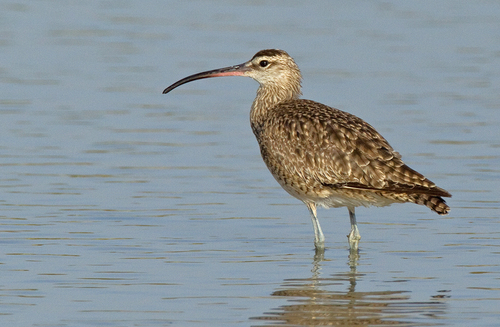
Whimbrel
The Whimbrel (Numenius phaeopus) is a widespread and captivating wading bird known for its long, decurved bill and distinctive calls. It plays a crucial role in coastal and wetland ecosystems as a predator of invertebrates, helping to regulate their populations. With its impressive migratory journeys spanning continents, the Whimbrel exemplifies the interconnectedness of global habitats. While not currently considered globally threatened, certain populations face localized pressures. The bird holds cultural significance in some regions, often appearing in folklore and representing the wildness of coastal landscapes.
37-47 cm
Length
75-90 cm
Wingspan
Least Concern
Conservation Status
Distribution
The Whimbrel boasts a vast breeding range across subarctic North America, Europe, and Asia. It undertakes extensive migrations, wintering along coastlines in South America, Africa, South Asia, and Australasia. Altitudinal range varies from sea level to subalpine tundra during breeding.
Lifespan
The oldest recorded Whimbrel lived over 21 years, but the average lifespan in the wild is likely shorter, around 10-12 years.
Whimbrel's Habitat
Habitat Types
Coastal mudflats, Salt marshes, Estuaries, Tundra, Grasslands (during migration), Rocky shores
Climate Zones
Subarctic, Temperate, Tropical
Adaptations
The Whimbrel's long, curved bill is a key adaptation for probing in mud and sand to extract invertebrates. Its long legs allow it to wade in shallow water. Their cryptic plumage provides camouflage in both breeding and wintering habitats.
Variations
Several subspecies are recognized, including *N. p. phaeopus* (Eurasian), *N. p. hudsonicus* (North American), and *N. p. variegatus* (East Asian). These differ subtly in plumage and size, and some debate exists about their taxonomic status.
Appearance
Breeding Plumage
Breeding plumage is generally more richly patterned with brown, buff, and black streaks and bars. Non-breeding plumage is somewhat duller and grayer.
Seasonal Feather Changes
The transition between breeding and non-breeding plumage occurs through molting periods after breeding and before migration.
Sex Based Plumage Differences
Sexual dimorphism in plumage is subtle. Females may have slightly less distinct head markings.
Notable Features
Long, decurved bill, Dark brown crown with a pale central stripe, Long, grayish legs, Brown and buff mottled upperparts
Diet and Feeding
Primary Foods
Crabs, Insects, Mollusks, Worms, Berries (during breeding season)
Foraging Behavior
Whimbrels primarily forage by probing in soft mud or sand with their long bills. They also pick prey from the surface and may chase after crabs. Feeding often occurs in intertidal zones, following the receding tide.
Specializations
The sensitive tip of the bill allows them to detect prey buried beneath the surface. The curvature of the bill is particularly well-suited for extracting crabs from burrows.
Seasonal Diet Variations
During the breeding season, Whimbrels consume more insects and berries. On their wintering grounds, they rely more heavily on marine invertebrates.
Behavior
Social Structure
Whimbrels are generally solitary or found in small groups during breeding. During migration and on wintering grounds, they can form larger flocks, sometimes numbering in the hundreds.
Communication
A distinctive, rippling "bibibibibibi" call, Alarm calls that are sharp and repeated, Whistling calls during courtship displays
Migration
Whimbrels are long-distance migrants. Some populations undertake non-stop flights of thousands of kilometers. They navigate using a combination of celestial cues, the Earth's magnetic field, and possibly landmarks.
Territorial or Group Behaviors
During the breeding season, Whimbrels are territorial, defending their nesting areas from intruders. On wintering grounds, they may defend feeding territories, particularly rich foraging patches.
Conservation
Threats
Habitat loss and degradation (coastal development, pollution), Climate change (sea-level rise, changes in prey availability), Hunting (in some parts of their range), Disturbance at staging and wintering sites
Protection Programs
International agreements like the Ramsar Convention on Wetlands, Regional flyway initiatives (e.g., the East Asian-Australasian Flyway Partnership), Designation of protected areas (e.g., national parks, wildlife refuges)
Local National Laws
Protected under various national laws, such as the Migratory Bird Treaty Act in the United States and Canada.
Population Trend
Stable overall, but some populations are declining.
Population Estimates
The global population is estimated to be around 1.4 - 2.1 million individuals.
Interesting Facts
Whimbrels can fly at speeds of up to 50 km/h (31 mph).
This allows them to cover vast distances during migration.
Their scientific name, *Numenius phaeopus*, refers to the crescent shape of their bill.
*Numenius* comes from the Greek words *neos* (new) and *mene* (moon), alluding to the new moon's shape.
Whimbrels sometimes use their bills to crack open the shells of small crabs.
This demonstrates their adaptability in foraging techniques.
The calls of whimbrels were used to predict weather.
In Shetland folklore, the call of the Whimbrel (known there as the 'May Bird') was said to predict rain if it was heard seven times in succession.
Faqs about Whimbrel
What is the difference between a Whimbrel and a Curlew?
Whimbrels are smaller than Curlews and have a shorter, less curved bill. Whimbrels also have a distinct striped head pattern.
Where can I see a Whimbrel?
Look for Whimbrels along coastlines during migration and in winter. During the breeding season, they are found in subarctic and arctic regions.
Are Whimbrels endangered?
The Whimbrel is currently classified as Least Concern by the IUCN, but some populations are facing threats and are declining.
How do Whimbrels find their way during migration?
Whimbrels use a combination of methods, including the position of the sun and stars, the Earth's magnetic field, and visual landmarks.
Copyright @ Nature Style Limited. All Rights Reserved.
 English
English